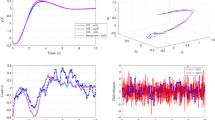Abstract
Robust positive sampled-data observer-based output-feedback energy-to-peak disturbance attenuation is challenging problem because of the following reasons. (i) The typical Luenberger observer has a limited structure for guaranteeing closed-loop positivity. (ii) The conventional sampled-data control framework has no lever to manage closed-loop positivity during sampling intervals and at sampling instants. (iii) A separation principle is to be established for this problem. In this paper, we propose an affirmative methodology to solve this problem.

Similar content being viewed by others
Notes
We found that the state-space model introduced by Yin et al. [16] is uncontrollable and unobservable.
References
Fridman E (2010) A refined input delay approach to sampled-data control. Automatica 46(2):421–427. https://doi.org/10.1016/j.automatica.2009.11.017
Haddad WM, Chellaboina V (2005) Stability and dissipativity theory for nonnegative dynamical systems: a unified analysis framework for biological and physiological systems. Nonlinear Anal Real World Appl 6(1):35–65. https://doi.org/10.1016/j.nonrwa.2004.01.006
Jee SC, Lee HJ (2022) Separation principle-based positive output-feedback \(l_{\infty }\)−\(l_{\infty }\) disturbance attenuation. J Electr Eng Technol 17:3499–3505. https://doi.org/10.1007/s42835-022-01128-w
Lee HJ (2022) Robust static output-feedback vaccination policy design for an uncertain SIR epidemic model with disturbances: positive Takagi–Sugeno model approach. Biomedical Signal Processing and Control 72:103273. https://doi.org/10.1016/j.bspc.2021.103273
Lee HJ (2023) Positivity and separation principle for observer-based output-feedback disturbance attenuation of uncertain discrete-time fuzzy models with immeasurable premise variables. J Franklin Inst 360(12):8486–8505. https://doi.org/10.1016/j.jfranklin.2023.03.047
Lee HJ (2023) Robust observer-based output-feedback control for epidemic models: Positive fuzzy model and separation principle approach. Appl Soft Comput 132:109802. https://doi.org/10.1016/j.asoc.2022.109802
Lee J, Moon JH, Jee SC, Lee HJ (2021) Robust \(\mathcal{L} _{\infty }\)−\(l_{\infty }\) sampled-data dynamic output-feedback control for uncertain linear time-invariant systems through descriptor redundancy. J Electr Eng Technol 16(2):1051–1058. https://doi.org/10.1007/s42835-020-00603-6
Lee J, Moon JH, Lee HJ (2021) Continuous-time synthesizing robust sampled-data dynamic output-feedback controllers for uncertain nonlinear systems in Takagi–Sugeno form: A descriptor representation approach. Inf Sci 565:456–468. https://doi.org/10.1016/j.ins.2021.02.032
Lee J, Moon JH, Lee HJ (2021) Robust \(\mathcal{H} _{\infty }\) and \(\mathcal {L} _{\infty }\)−\(\mathcal {L} _{\infty }\) sampled-data dynamic output-feedback control for nonlinear system in T–S form including singular perturbation. Int J Syst Sci 52(7):1315–1328. https://doi.org/10.1080/00207721.2020.1856448
Liu L, Zhang J, Shao Y, Deng X (2020) Event-triggered control of positive switched systems based on linear programming. IET Control Theory Appl 14(1):145–155. https://doi.org/10.1049/iet-cta.2019.0606
Moon JH, Lee HJ (2021) Sampled-data control of underwater gliders: digital redesign approach. Int J Control. https://doi.org/10.1080/00207179.2019.1638969
Nam PT, Thuan LQ, Nguyen TN, Trinh H (2021) Comparison principle for positive time-delay systems: An extension and its application. J Franklin Inst 358(13):6818–6834. https://doi.org/10.1016/j.jfranklin.2021.07.013
Nguyen CM, Pathirana PN, Trinh H (2018) Robust observer-based control designs for discrete nonlinear systems with disturbances. Eur J Control 44:65–72. https://doi.org/10.1016/j.ejcon.2018.09.002
Shu Z, Lam J, Gao H, Du B, Wu L (2008) Positive observers and dynamic output-feedback controllers for interval positive linear systems. IEEE Trans Circuits Syst I Regul Pap 55(10):3209–3222. https://doi.org/10.1109/tcsi.2008.924116
Xie L (1996) Output feedback \({H}_{\infty }\) control of systems with parameter uncertainties. Int J Control 63(4):741–750. https://doi.org/10.1080/00207179608921866
Yin OQ, Tomlinson B, Chow AH, Chow MS (2003) A modified two-portion absorption model to describe double-peak absorption profiles of ranitidine. Clin Pharmacokinet 42(2):179–192. https://doi.org/10.2165/00003088-200342020-00005
Zemouche A, Rajamani R, Kheloufi H, Bedouhene F (2017) Robust observer-based stabilization of Lipschitz nonlinear uncertain systems via LMIs - discussions and new design procedure. Int J Robust Nonlinear Control 27(11):1915–1939. https://doi.org/10.1002/rnc.3644
Zhang D, Du B (2022) Event-triggered controller design for positive T-S fuzzy systems with random time-delay. J Franklin Inst 359(15):7796–7817. https://doi.org/10.1016/j.jfranklin.2022.08.024
Zhang J, Feng G (2014) Event-driven observer-based output feedback control for linear systems. Automatica 50(7):1852–1859. https://doi.org/10.1016/j.automatica.2014.04.026
Acknowledgements
This work was supported by Inha University Research Grant.
Author information
Authors and Affiliations
Corresponding author
Ethics declarations
Conflicts of interest
On behalf of all authors, the corresponding author states that there is no conflict of interest.
Additional information
Publisher's Note
Springer Nature remains neutral with regard to jurisdictional claims in published maps and institutional affiliations.
Rights and permissions
Springer Nature or its licensor (e.g. a society or other partner) holds exclusive rights to this article under a publishing agreement with the author(s) or other rightsholder(s); author self-archiving of the accepted manuscript version of this article is solely governed by the terms of such publishing agreement and applicable law.
About this article
Cite this article
Jee, S.C., Lee, H.J. Positive Sampled-Data Disturbance Attenuation: Separate Design. J. Electr. Eng. Technol. 19, 1807–1815 (2024). https://doi.org/10.1007/s42835-023-01637-2
Received:
Revised:
Accepted:
Published:
Issue Date:
DOI: https://doi.org/10.1007/s42835-023-01637-2




